Good for you, good for your PC! Follow these steps to check computer CPU temperature.

Why should you check the CPU temperature? Simple: you want your PC to work as well and as long as possible.
Too high a CPU temperature leads to reduced performance and, in the worst case, even permanent damage and a shortened lifespan. You can prevent this by monitoring the CPU temperature and taking the right steps if the temperature is too high.
You can read here how to check the temperature, what to do if it is too high and how to prevent too high temperatures!
What does the CPU temperature say?
The CPU temperature is the temperature of your PC’s processor. Don’t get confused: the CPU is the processor. It is responsible for processing and performing computer tasks: it is the brain of your PC. As soon as it overheats , you will soon see that your PC slows down and, in the worst case, even gets damaged. 😵
If we humans get too hot, we are more difficult to burn ahead. This is because our body goes into low-power mode to prevent overheating. Will you continue despite this signal from your body? Then you run the risk of heat stroke and then you are further away from home.
The same thing happens with the CPU. If the temperature rises too high, the CPU takes a step back. It then regulates its own activities to prevent further heat from being released. We call this thermal throttling.
For example, you see that a processor switches its clock speed back from 3 GHZ to 800 MHZ. This results in a (significant) decrease in the performance of your PC.
When a CPU is exposed to too high a temperature for too long, the CPU may shut itself down.
In the worst case, exposure to (very) high temperatures leads to permanent damage to the CPU or other parts of your PC, such as the video card or even the motherboard.
What is also no fun is that too high CPU temperatures – even without permanent damage as a result – shorten the life of your PC.
What is a good and what is a too high CPU temperature?
I think it is clear that a good CPU temperature is important. But what is a good temperature for your CPU and when is it too high? Logical if you ask yourself this. Fortunately, I’ll give you the answer here. 😉

The ideal CPU temperature varies by CPU. Where one CPU only switches back from 100°C, another CPU switches off completely at 100°C, because this temperature can be catastrophic for your PC. This is because each CPU has a different maximum temperature.
The maximum temperature is the maximum temperature to which a CPU functions normally and does not suffer. This also means that the ideal CPU temperature differs per CPU. Usually the following applies: the lower (to a certain extent: think no colder than 10°C) the better.
A general guideline is:
- Between 20°C and 40°C : these are good temperatures when idle or when performing very light tasks.
- Between 40°C and 65°C : these temperatures are good for normal activities.
- Between 65°C and 75°C : This is around the maximum temperature of some CPUs. These temperatures are often still OK and you mainly see them when performing multiple tasks at the same time or when performing a somewhat heavier task.
- Between 75°C and 85°C : you sometimes see these temperatures when performing heavy tasks, such as playing games. It depends on your CPU whether this can hurt or not, but I advise you to keep an eye on it anyway.
- Above 85°C : Temperatures above 85°C are usually not good for your CPU. It may happen once, but it is important to lower the temperature.
Please note that this is only a guideline. For example, the CPU of a good gaming PC and the best desktop will soon have a higher maximum temperature than the CPU of a budget laptop.
Is the maximum temperature of your CPU relatively high ? Then it probably isn’t a problem if the CPU temperature exceeds the temperatures of the guideline. Is the maximum temperature relatively low ? Then these temperatures may already be too high.
I recommend that you check the maximum temperature of your CPU and insist that you don’t have to deal with temperatures up to 10°C below the maximum temperature.
Is the temperature rising or does it exceed the maximum temperature? Then it’s time to take action. You will read more about that soon. First, let’s look at how to monitor CPU temperature.
Clock speed and overclocking 🕓
The heavier a task, the harder the CPU has to work. How fast a CPU is depends on a few different things, including its clock speed.
The clock speed indicates how fast one processor core performs its task. Most CPUs have multiple cores.
A CPU with a high clock speed and only one core performs one task very quickly. A CPU with a high clock speed and two cores performs two tasks very quickly, and so on.
And then the term “overclocking” comes into play. By overclocking your CPU, you exceed the recommended maximum clock speed. This leads to better performance: ideal, right? Roughly: The major danger and problem in overclocking is overheating.
If you plan on overclocking, it’s important to keep a close eye on your CPU temperature by checking it regularly!
Check CPU temperature
And now to the heart of the matter: how do you check the temperature of your PC? There are several answers to that. How you check the CPU depends on your preferences and your operating system. Below you will find various options for Apple and Windows PCs. ⬇️
Via the BIOS menu (Windows)
On many Windows PCs, it is possible to view the CPU temperature in the BIOS (basic input/output system) menu or in the UEFI (unified extensible firmware interface) menu. Functionally they are the same.
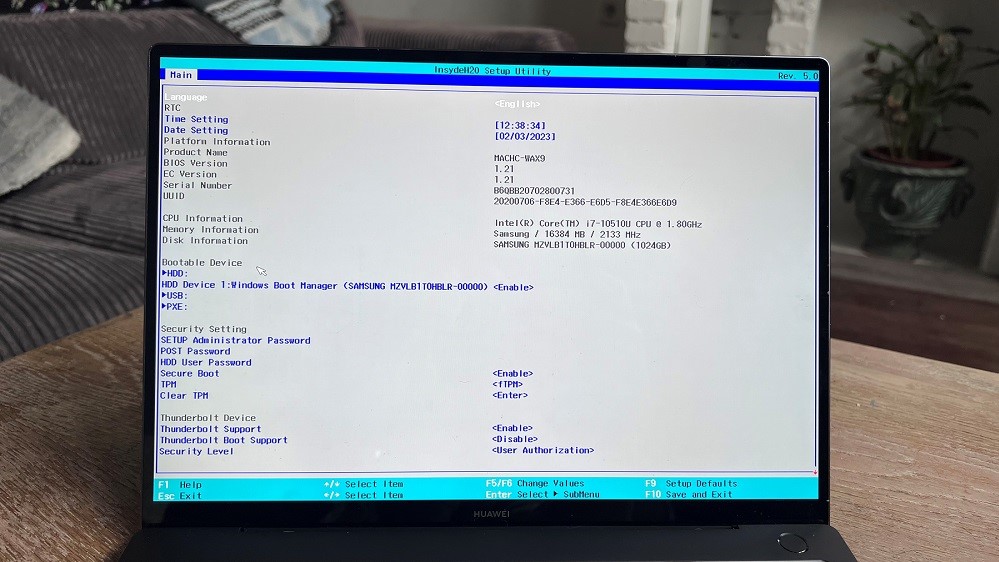
There are two ways to get into the BIOS or UEFI menu. The first option is via the ‘BIOS key’. This is a specific key to open the menu. Restart your PC and click the specific key to open the menu.
The key differs per PC. In this list you can see the specific keys per motherboard brand. For laptops and many pre-built branded PCs, that brand equates to the manufacturer of the laptop or PC.
Is your PC not listed or is it not working? Fortunately, there is a second way. The second option is to get into the BIOS or UEFI menu through the settings.
To do this, go to the system recovery settings.
- On Windows 10, open the settings, go to Update & Security > System Restore.
- On Windows 11, open the settings, navigate to System > System Restore.
For both, click Restart Now under Advanced Startup Options. Your PC will now restart and open the boot menu. From this menu, choose Troubleshoot > Advanced Options > UEFI Firmware Settings. Here, choose Restart.
You are now in the BIOS or UEFI menu. In modern menus, the CPU temperature appears on the main page. For older menus, click on the Power or H/W Monitor heading. After that you will see the CPU temperature.
There are three drawbacks to checking the CPU temperature through the BIOS or UEFI menu. First of all, not every menu of every PC offers the possibility to view the CPU temperature.
In addition, many BIOS and UEFI menus show the CPU temperature and not the core temperature. The CPU temperature is more accurate at low temperatures, but the core temperature is more accurate at high temperatures, and it is precisely those higher temperatures that are important to monitor.
Finally, shut down your PC to enter the BIOS or UEFI menu. Besides the fact that you have to stop everything you are doing (which is not always convenient), you only measure a snapshot when the PC has not performed a specific task for a while – depending on the restart time.
Do you not see the temperature in the BIOS or UEFI menu, or do you prefer another method without the above disadvantages? Then look at the other options in this article. 😁
Via Core Temp (Windows)
Core Temp is a free and simple program to measure your CPU temperature. Core Temp takes up little space and has several useful features. To use Core Temp, a few steps are required.
Download and install Core Temp
- Download Core Temp and install this program.
- Accept the license terms to continue and choose the destination folder. The destination folder is usually set correctly by default.
- Then you will see Select additional tasks. Pay close attention to the check marks here. As is often the case with free software, there is a box checked to download another program. Make sure you uncheck this box. ⚠️
- Then click Install > Finish. The installation of Core Temp is now complete.
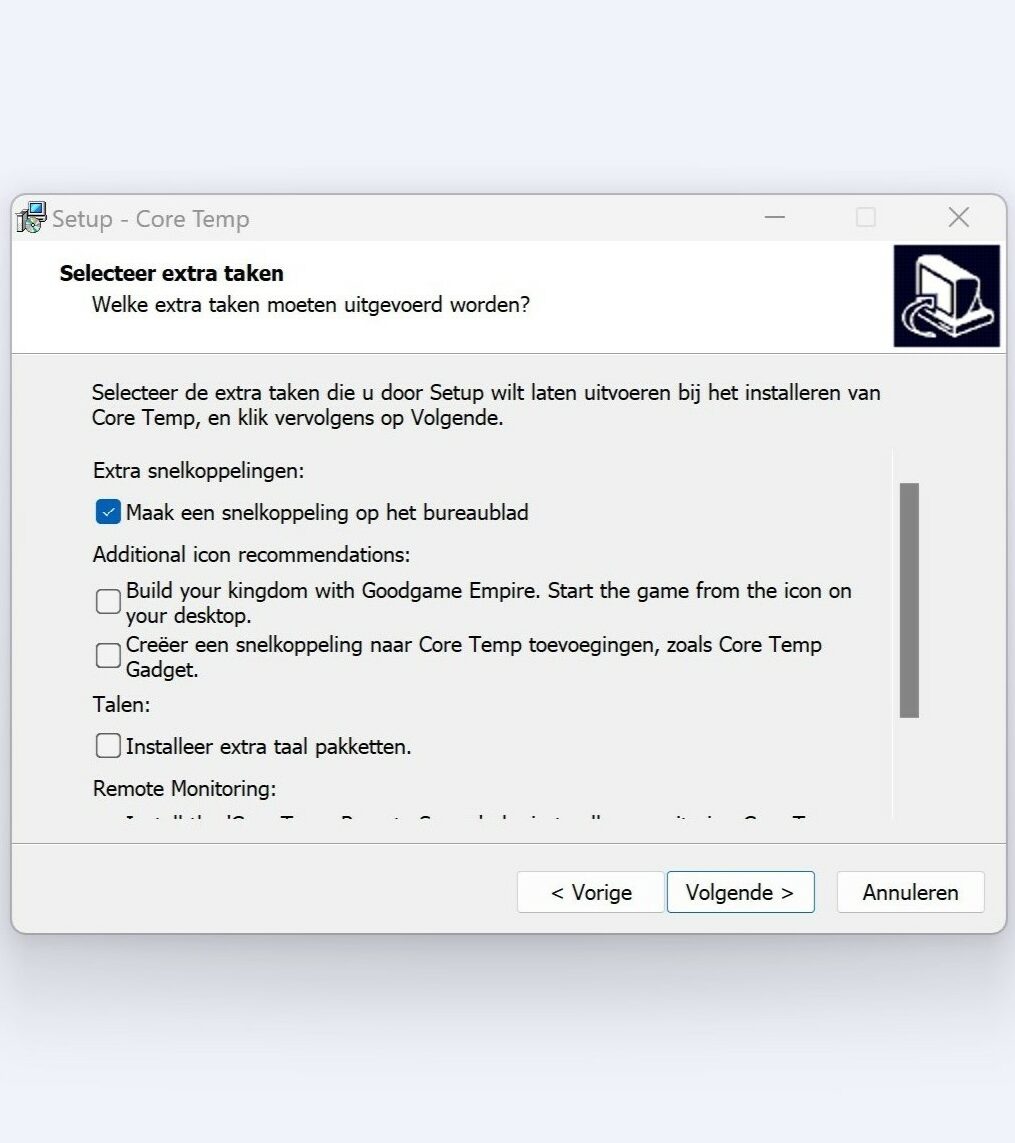

Using Core Temp
Open Core Temp. You should now see Processor #0: Temperature Readings at the bottom of the window. Below you can see some information about your CPU. Important are the TJ. Max and the cores. The temperature behind TJ. Max is the maximum temperature of your CPU.
You also see the number of cores of your CPU and the corresponding real-time temperature, the minimum temperature (the lowest measured temperature), the maximum temperature (the highest measured temperature) and the load (active load).
It is also possible to read the temperature of the CPU cores without opening Core Temp. Click the up arrow in the taskbar to display the hidden icons. Here you can see the current temperatures of the cores at a glance. 👌
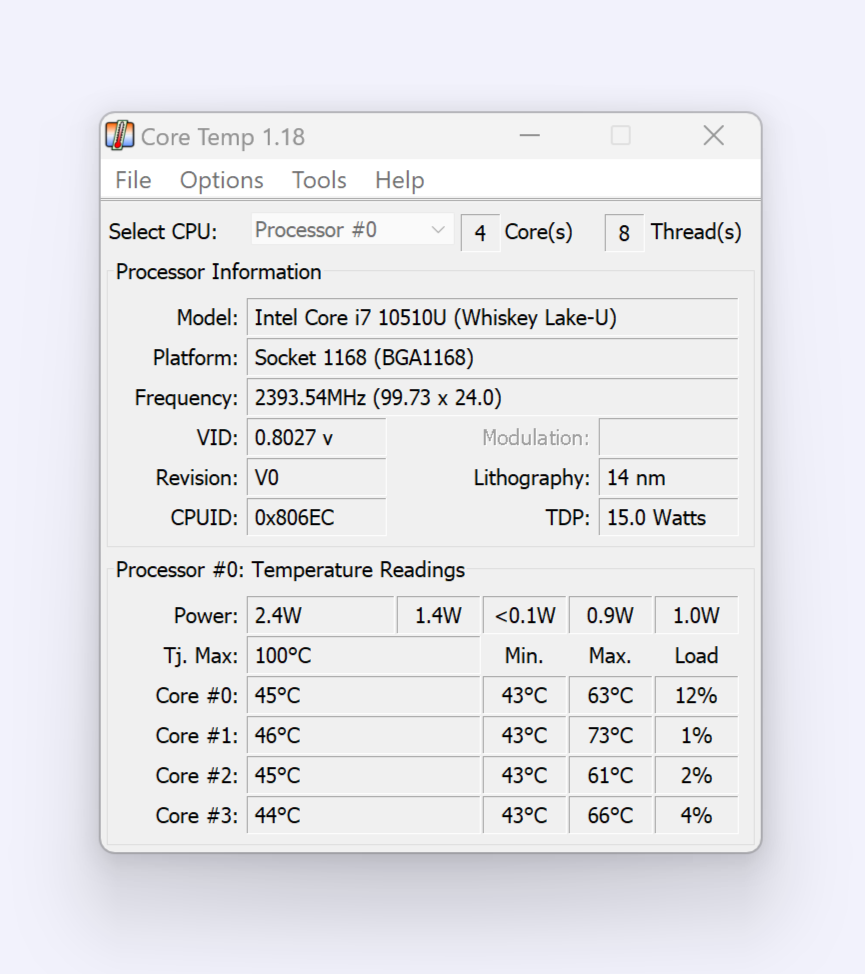

Additional settings of Core Temp
Core Temp provides several useful options to configure the program to your liking. You can see some of those settings here:
- Start Core Temp at the same time as Windows : Go to Options > Settings > General. Check Start Core Temp with Windows here.
- Start Core Temp in a minimized window : Go to Options > Settings > Display and check Start Core Temp minimized here.
- Set Core Temp to display on hidden icons : Go to Options > Settings > Notification area. Choose here which data you see with the hidden icons.
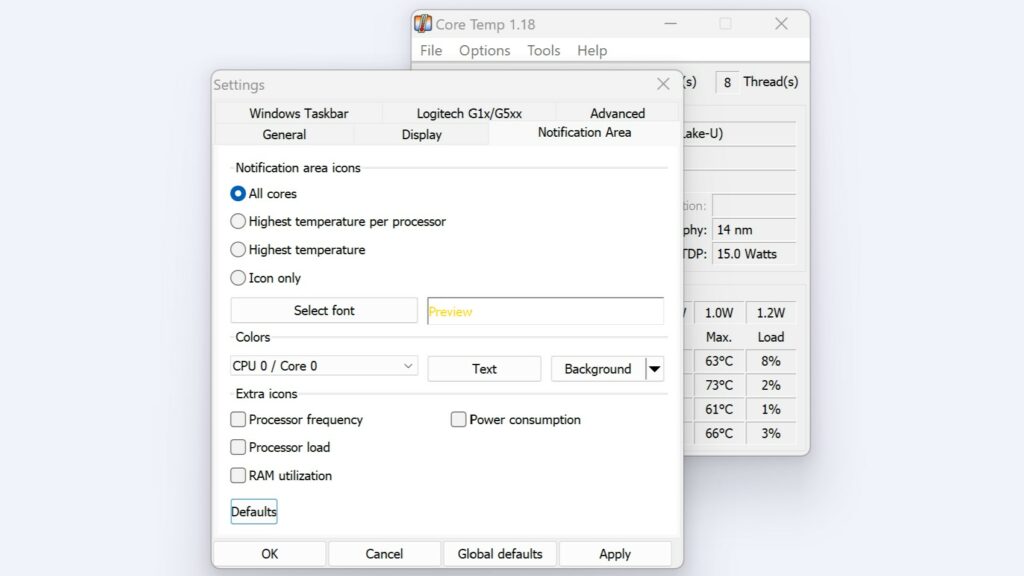
Via Open Hardware Monitor (Windows)
Another common feature for Windows PCs is Open Hardware Monitor. This program is also free.
The advantage of Open Hardware Monitor is that it also provides information about other components, such as the video card. The disadvantage is that the program is less clear and it displays the CPU temperature in less detail.
Open Hardware Monitor is ideal if you like to get more information than just CPU temperature information, and if Core Temp is not working (properly) for some reason.
To use Open Hardware Monitor, first download the program from the download page. This is a zip file. Open the file and open the first folder you see: OpenHardwareMonitor. Double-click on OpenHardwareMonitor.exe and choose Extract All.
After extracting, repeat the above steps in the extracted folder to start the installation. And that’s it: Open Hardware Monitor now opens automatically!
You can immediately see all the information on the main page. Under the CPU you see per core the current value (value) and the maximum measured value (max) of the clock speed, temperature and load. The minimum measured value and the maximum temperature of your CPU are missing.
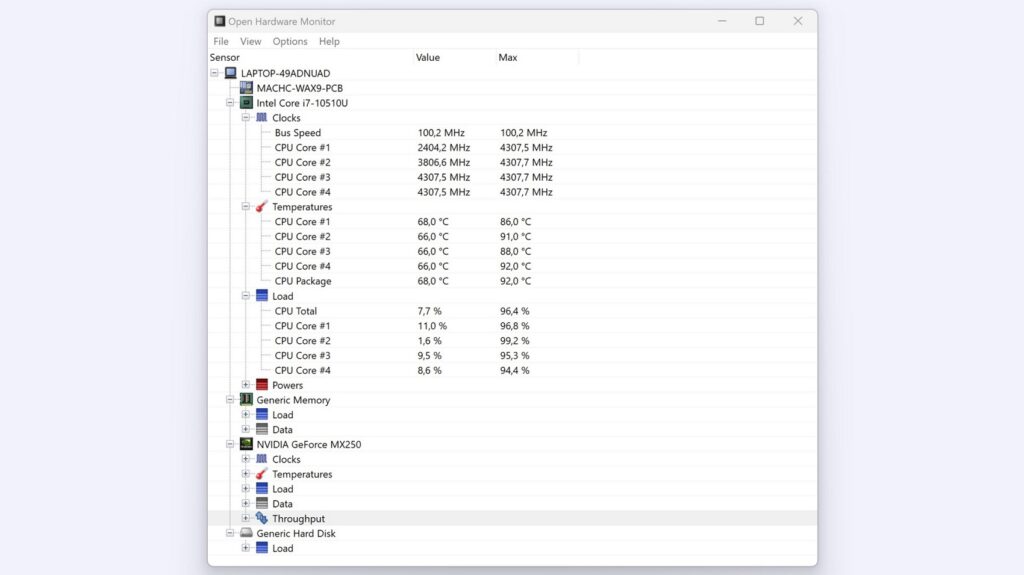
Via the Apple Terminal (macOS)
If you have a Mac with an Intel processor, this is the easiest way to check the CPU temperature. Do you have a Mac with Apple Silicon (M1 or M2 processor)? Then take a look at the other options.
Entering this command in the terminal will give you a constant display of your CPU’s temperature:
sudo powermetrics --samplers smc |grep -i "CPU die temperatureTo do this, follow these steps:
- Open the terminal.
- The first option is to open Finder. Here navigate to Apps > Utilities >Terminal.
- The second option is to search by pressing the CMD key and spacebar at the same time. Then type in Terminal and select the terminal.
- Type or paste the above command into the terminal and hit Enter key.
- When prompted by your Mac, enter your password and press enter again.
And it’s done! The current temperature now appears in the terminal. By leaving the terminal open, you can easily keep an eye on things. 👀

Via Hot (macOS)
Hot is a free app to check the CPU temperature of Macs. The app works on Macs with an Intel processor and on Macs with Apple Silicon.
This app displays the current temperature and whether the CPU is running at full speed. This way you can immediately see whether there is thermal throttling. The app also gives you an overview of the measured temperature over a longer period of time.
You can download hot from the iMazing download site. Scroll down until you see the Hot app and hit download. After the download is complete, open Finder and drag the app from Downloads > Apps.
It is possible to open the app from the Apps folder in Finder, but an icon also appears in the menu bar. From here you can read the current temperature and also open the app.
In the app you set various things, such as the temperature in degrees Celsius or Fahrenheit, and you see data such as the temperature measured over a longer period of time.
Via TG Pro (macOS)
TG Pro also works on both Macs with an Intel processor and Macs with Apple Silicon. One drawback: the program is n’t free. That said, you also get more in return. Unlike Hot, you get more information than just the CPU.
This way you also get information about the GPU, battery, hard disk, circuit board, power supply and connections.
As for the CPU temperature, you also get some useful options, such as setting an alarm at high temperatures via a notification or email, and automatically or manually optimizing the fans.
Download TG Pro and follow the same steps as with the Hot app. The app icon appears in the menu bar. Here you can immediately see the CPU temperature.
For more details, open the app. In the main window you can see an overview of all internal temperatures, information about the fans and a diagnosis about the hardware. On the left you choose from the different components to get more information about one of these components.
It is the only paid app in this list, but also the only app that offers you so much insight and control.

Alternative methods
In addition to the described ways to check the temperature of your CPU, there are dozens of other programs to do this. Because there are so many of them, I will not describe them here.
The above programs are suitable for almost everyone. Do you prefer a different program? Keep in mind that not every program works equally well or is equally reliable.
Prefer not to install a program? Then a USB thermometer is another option. You connect this to your PC. The USB then measures the temperature with built-in sensors.
With the help of a (supplied) software program, you can see the temperature – possibly measured over a longer period – and you can set things such as an alarm at a certain temperature.
With a USB thermometer, pay close attention to the accuracy and whether it is compatible with your PC’s operating system.
Prevent too high CPU temperature
Prevention is better than cure. So let’s take a look at how to prevent the CPU temperature from rising too high.
There are multiple causes that may lead to a too high CPU temperature. Causes include too high an ambient temperature, poor ventilation and improper use. Below are some tips to prevent your CPU temperature from being unnecessarily high:
- Keep your PC up-to-date. Make sure to install all software updates for your PC unless you know what you’re doing. These updates keep your PC and its components, including your CPU, performing at their best.
- Use the PC in the right environment. The temperature of the CPU is sensitive to the ambient temperature. Use the PC as little as possible in temperatures above 35°C and avoid the sun shining on the PC for a long time.
- Do not obstruct ventilation. Good ventilation is important to remove hot air. Therefore, don’t put anything in your PC’s vents, don’t place anything in front of them if possible, and place your PC on a flat, non-fabric surface.
- Use the correct charger. Using the wrong charger can cause the battery to overheat. Besides the fact that this is not good for your battery, it also causes the CPU temperature to rise.
- Turn off your PC when it is not in use. If you’re not using your PC, there’s little chance that the CPU will be so heavily loaded that it overheats. Nevertheless, it is possible, because background tasks also require some of the CPU. Therefore, turn off your PC when you are not using it.
Keeping these tips in mind will reduce the chance of your PC overheating. However, this is no guarantee that it will prevent overheating. Some causes are beyond your control, such as a CPU that is not sufficient for the heavy tasks you may want to perform.
Reduce CPU temperature
If you see that your CPU temperature is too high, or at least higher than desired, that’s not the end of the world. Because prevention is not possible? Then it’s a matter of healing! 😁
If you notice that the temperature of the CPU is getting too high, chances are that the CPU is overheating from running many or very heavy tasks.
Instead of waiting for the CPU to take a step back, which leads to thermal throttling, it’s better to take a step back yourself sooner.
Do you notice that you already have to take this step back with normal tasks? And do you use your PC or laptop under normal circumstances and is there nothing you can do to prevent excessive temperatures? Then additional action is needed.
A possible cause is that unnecessary background processes are running or that there is a virus on the PC. A look at task manager, a virus scan or an ‘internal cleaning’ can do no harm.
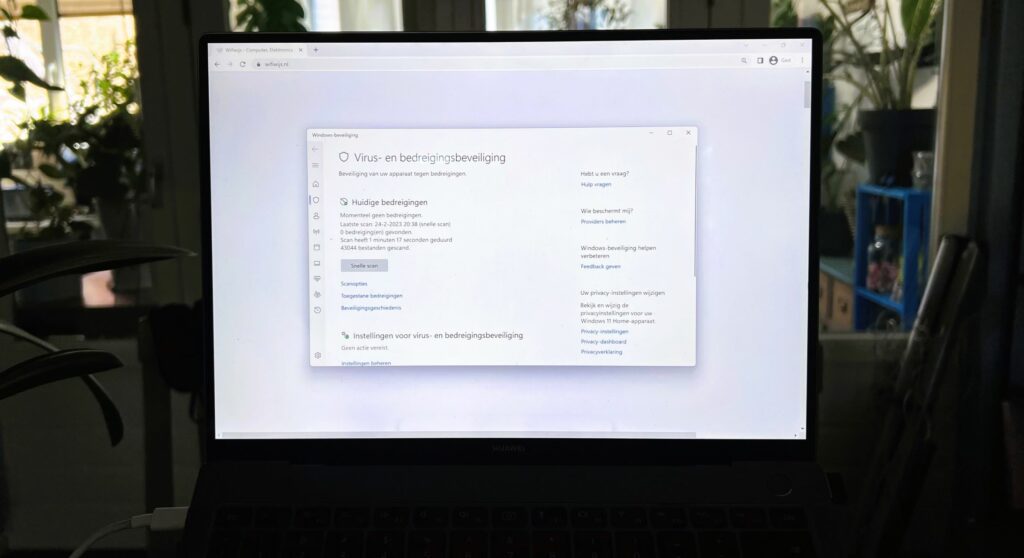
In some cases an ‘external cleaning’ is necessary – for example if too much dust has entered the ventilation. It is also possible that the thermal paste on the CPU has dried out and needs a new layer.
For all of the above, if you know what you’re doing, try to fix it yourself. Don’t know what you’re doing? Then I advise you to call in a professional.
Would you rather experiment with other solutions before you hire someone? In some cases, it’s as simple as placing a laptop stand under your laptop , or increasing the distance between your PC’s fan and surrounding objects to improve airflow.
Isn’t this already a solution? Then consider purchasing a good CPU cooler or a laptop stand with active cooling.
Have you completed the entire list and are you still not seeing any results? Then there are two possibilities: your CPU is broken, or not powerful enough to perform what you ask of it. 😅
Conclusion
The best thing to do is to prevent the CPU temperature from being too high. Is the temperature too high? Then it is important to take action.
But that’s pretty inconvenient if you have no idea what the temperature of your CPU is. Therefore, checking the CPU temperature is crucial for the functioning of your PC.
Hopefully, after reading this article, you will know exactly how to do that. There are many ways, the best of which are described here. Do you have any comments or comments? Then let us know. Thank you for reading!